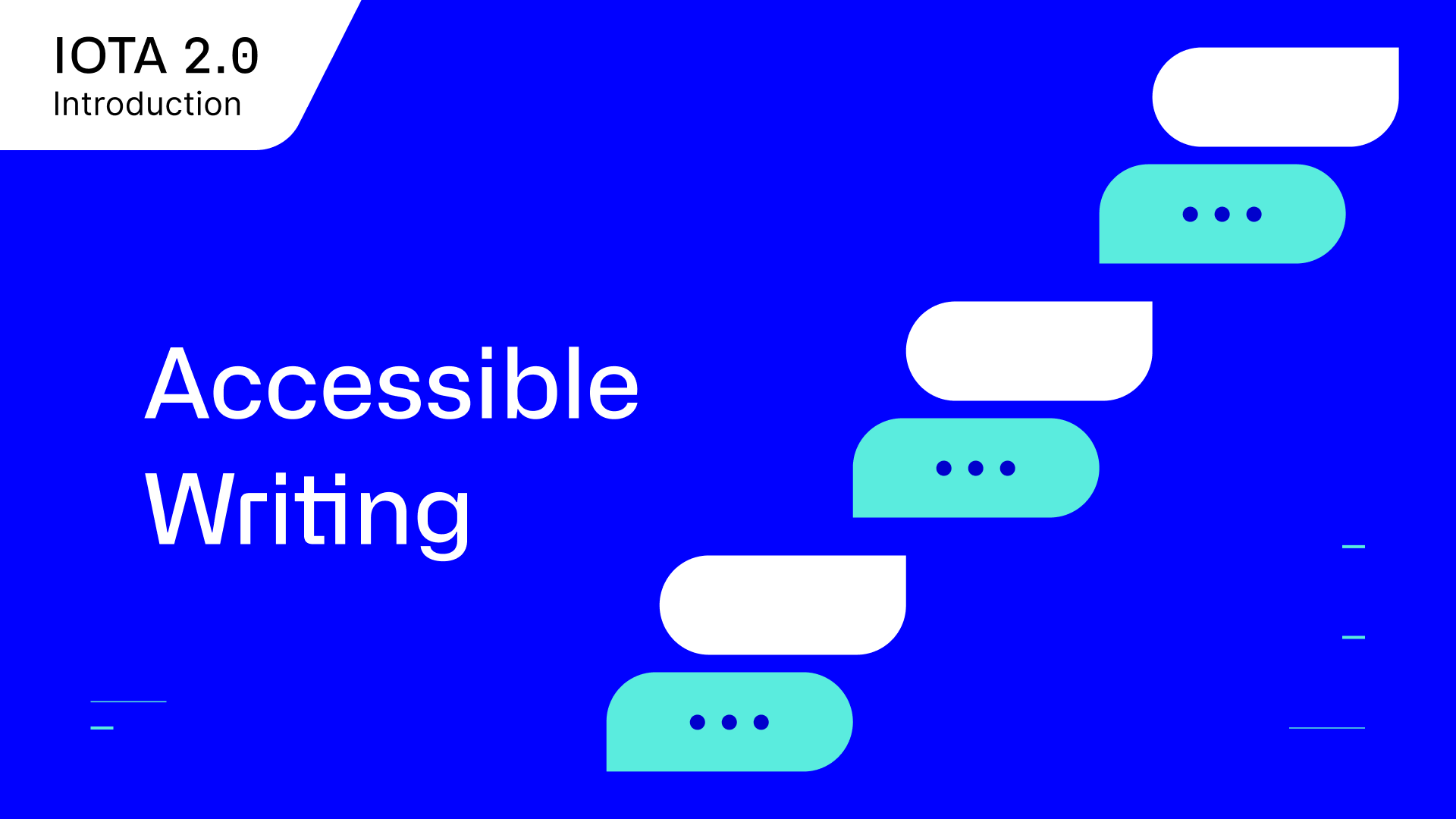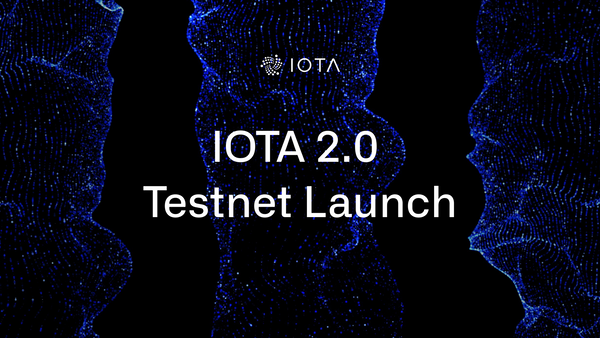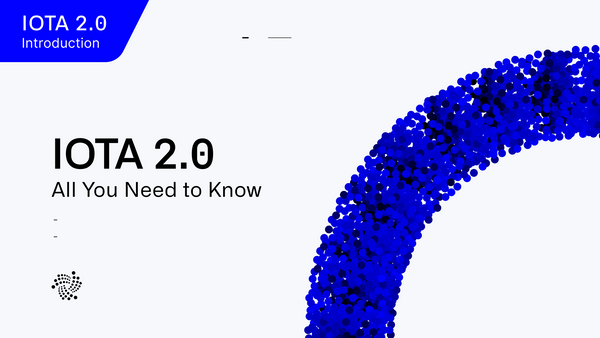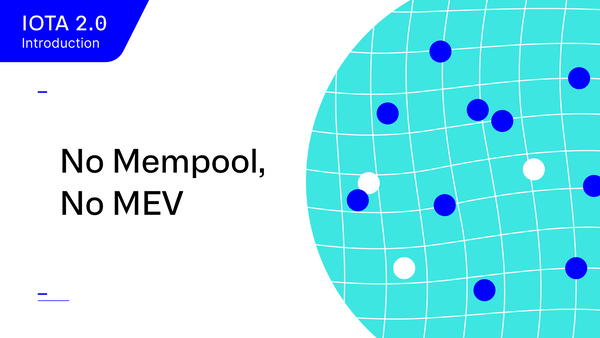Accessible Writing: Lowering the Barriers to Entry
IOTA 2.0 Introduction Part 16
TL;DR:
IOTA 2.0 emphasizes accessibility in Distributed Ledger Technology (DLT), enabling users to interact with the ledger without barriers. It achieves this by empowering every token holder to issue blocks independently, eliminating token fees, ensuring fair network use, and maximizing network capacity through efficient design. This approach ensures digital autonomy, enabling users to manage assets freely and contribute to network decisions.
In the final installment of our introductory series on IOTA 2.0, we delve into one of its key principles: Accessibility. In the context of Distributed Ledger Technology (DLT), accessibility means enabling every user to interact with the DLT by writing in the ledger without barriers. This process, integral to the functioning of any DLT, involves creating and propagating blocks, validating information, and ensuring confirmation. Accessible Writing is the smoothest possible implementation of this process, central to the widespread adoption of the protocol and the realization of digital autonomy.
In essence, IOTA 2.0's vision of digital autonomy hinges on accessibility. Users must be able to easily access the ledger to exercise control over their assets, avoid unnecessary costs, and contribute to network decisions. Achieving truly accessible writing involves enabling users to include information in the ledger without dependencies on others. IOTA 2.0 addresses this by eliminating the necessity of payment for issuing blocks and ensuring the network's ability to handle a large volume of blocks per second, thus paving the way for true accessibility in writing on the ledger.
The IOTA 2.0 protocol incorporates components to meet these requirements, which we'll explore further in this blog post.
Component 1: Every IOTA Token Holder is a Block Issuer

From its inception, the IOTA protocol has striven to make the best possible use of its DAG architecture (you can read more about this in Part 10 of this series, An Obvious Choice: Why DAGs Over Blockchains?). The DAG allows blocks to be included in the network at any point in time and decouples the consensus from block issuance. These features are crucial because they enable a straightforward, efficient solution: empowering users to create their own blocks.
Standard blockchains can’t provide this capability due to their reliance on a single, heaviest chain, necessitating the determination of the next block issuer or a decision on which block among many to include. This creates a dependency between users who just want to include information in the block (i.e. interact with the ledger) and the issuer. In contrast, IOTA's DAG architecture allows every user the freedom to issue their blocks. This empowerment means users can independently manage their assets by buying, selling, or transferring them at any moment.
Component 2: IOTA is Feeless for Token Holders

Every DLT must handle congestion to process incoming blocks effectively and reach consensus on the ledger state. Traditional blockchains let validators decide which information makes it into the ledger through the issuance of blocks. This setup encourages competition among users for the validator’s services and transaction fees extracted from the base token. As a result, value is extracted from users and given to a narrow class of validators. It also exposes users to a larger degree to issues like Maximal Extractable Value (MEV) and censorship, where validators have excessive control over ledger content due to their dual roles in ledger access and consensus.
In IOTA 2.0, as detailed in our blog posts on tokenomics and congestion control, a robust system is built to manage congestion without token fees. This system revolves around Mana, generated by holding tokens, decaying over time, and consumed when issuing blocks. The scheduler allocates throughput based on Mana holdings. This innovative approach eliminates traditional fees, replacing them with a model where ledger access is central, contributing to the long-term value of the network. This self-sustaining system, combined with users' ability to issue their own blocks, ensures fair network usage proportional to users' tokens (and thus its commitment to the network), granting full control over their assets.
Component 3: Network Capacity and Efficiency

The last two components talk about autonomy, the ability the protocol gives the user to control all their assets. Now we deal with the undeniable fact that BPS (blocks per second) matters! Autonomy can only be exercised if the network has enough capacity to process transactions. If demand exceeds the network's capacity, exceeding transactions won't make it through. In such a scenario, users' allowed throughput may become too low, delaying their ability to issue blocks and undermining the autonomy and control over assets that IOTA aims to provide. This situation might force users to buy access from others, contradicting the feeless nature of the system. Buying Mana is an option for those who momentarily require more transactions per second, and not a requirement to use the network. It's crucial to maintain high network capacity to avoid these issues, as discussed in Part 2 of our blog series, emphasizing the fundamental principles every DLT needs.
IOTA 2.0 addresses this challenge by maximizing efficiency and boosting network capacity, with its modules designed to achieve this goal:
- The choice of a Directed Acyclic Graph (DAG) network structure enables Parallel Execution and Stream Processing, optimizing hardware and bandwidth usage (see An Obvious Choice: Why DAGs Over Blockchains?).
- The consensus mechanism makes swift decisions and handles multiple conflicts simultaneously through the conflict DAG (see A New Consensus Model: Nakamoto Consensus on a DAG).
- The confirmation process is built to safely reach safe confirmation within seconds (see Confirming Blocks: How Validators Operate).
These three design components ensure IOTA 2.0 achieves maximum capacity while maintaining rapid confirmations, preserving the core principles of autonomy and feeless usage.
A Map of IOTA 2.0
This concludes our series of blog posts that introduce the forthcoming IOTA 2.0 protocol. The series began by describing our vision of digital autonomy for everyone before explaining how IOTA 2.0 will overcome blockchain challenges to achieve that vision. This blog post concludes the introduction by showing how the key point of accessibility is achieved, and how components we've encountered throughout the previous blog posts contribute to it.
This may be the last blog post of this series, but there’s more to come in the future. As we always strive to build something even greater, we look forward to building a DLT that can make our community proud and go further than what has been achieved before. Together, with you all, going beyond IOTA 2.0.
IOTA 2.0 Introduction
Part 1: Digital Autonomy for Everyone: The Future of IOTA
Part 2: Five Principles: The Fundamentals That Every DLT Needs
Part 3: Data Flow Explained: How Nodes Process Blocks
Part 4: Data Structures Explained: The Building Blocks that Make the Tangle
Part 5: Accounts, Tokens, Mana and Staking
Part 6: A New Consensus Model: Nakamoto Consensus on a DAG
Part 7: Confirming Blocks: How Validators Operate
Part 8: Congestion Control: Regulating Access in a Permissionless System
Part 9: Finality Explained: How Nodes Sync the Ledger
Part 10: An Obvious Choice: Why DAGs Over Blockchains?
Part 11: What Makes IOTA 2.0 Secure?
Part 12: Dynamic Availability: Protocol-Based Assurances
Part 13: Fair Tokenomics for all Token Holders
Part 14: UTXO vs Accounts: Merging the Best of Both Worlds
Part 15: No Mempool, No MEV: Protecting Users Against Value Extraction
Part 16: Accessible Writing: Lowering the Barriers to Entry




